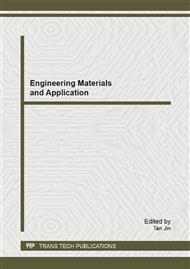[1]
B. Mohan, A. Rajadurai and K.G. Satyanarayan: Electric discharge machining of Al-SiC metal matrix composites using rotary tube electrode, Journal of Materials Processing Technology, (153-154), 978-985, (2004).
DOI: 10.1016/j.jmatprotec.2004.04.347
Google Scholar
[2]
Y. Oguzhan and M.A. Okka: Effect of single and multi-channel electrodes application on EDM fast hole drilling performance, International Journal of Advanced Manufacturing Technology, 51, 185-194, (2010).
DOI: 10.1007/s00170-010-2625-3
Google Scholar
[3]
S. Singh, S. Maheshwari and P.C. Pandey: Some investigations into the electric discharge machining of hardened tool steel using different electrode materials, Journal of Materials Processing Technology, 149, 272-277, (2004).
DOI: 10.1016/j.jmatprotec.2003.11.046
Google Scholar
[4]
C.C. Wang and B.H. Yan: Blind-hole drilling of Al2O3/6061Al composite using rotary electro-discharge machining, Journal of Materials Processing Technology, 102, 90-102, (2000).
DOI: 10.1016/s0924-0136(99)00423-9
Google Scholar
[5]
P. Koshy, V.K. Jain, and G.K. Lal: Mechanism of material removal in electrical discharge diamond grinding, International Journal of Materials Processing Technology, 1173-1185, (1995).
DOI: 10.1016/0890-6955(95)00103-4
Google Scholar
[6]
K.P. Rajurkar, B. Wei and J. Kozak: Abrasive electro-discharge grinding of advance materials, ISEM, 863-869, (1995).
Google Scholar
[7]
S.K. Choudhury, V.K. Jain and M. Gupta: Electrical discharge diamond grinding of high speed steel, International Journal of Machining Science and Technology, 3 (1), 91-105, (1999).
DOI: 10.1080/10940349908945685
Google Scholar
[8]
B.H. Yan and C.C. Wang: The machining characteristics of Al2O3/6061Al composite using rotary electro discharge machining with a tube electrode, Journal of Materials Processing Technology, 95, 22-231, (1999).
DOI: 10.1016/s0924-0136(99)00322-2
Google Scholar
[9]
B.H. Yan, C.C. Wang, W.D. Liu and F.Y. Huang: Machining characteristics of Al2O3/6061Al composite using rotary EDM with a disk like electrode, International Journal of Advanced Manufacturing of Technology, 16 (5), 322-333, (2000).
DOI: 10.1007/s001700050164
Google Scholar
[10]
K.M. Shu, H.R. Shih and G.C. Tu: Electrical discharge abrasive drilling of hard materials using a metal matrix composite electrode, International Journal of Advanced Manufacturing Technology, 29, 678-87, (2006).
DOI: 10.1007/s00170-005-2571-7
Google Scholar
[11]
S.K.S. Yadav, V. Yadava and V.L. Narayana: Experimental study and parameter design of electro-discharge diamond grinding, International Journal of Advanced Manufacturing Technology, 36, 34-42, (2008).
DOI: 10.1007/s00170-006-0820-z
Google Scholar
[12]
A. Iosub, E. Axinte and F. Negoescu: A study about micro-drilling by electrical discharge method of an Al/Sic hybrid composite, International Journal of Academic Research, 2 (3), 6-12, (2010).
Google Scholar
[13]
B.C. Abothula, V. Yadav and G.K. Singh: Development and experimental study of electro-discharge face grinding, Materials and Manufacturing Processes, 25, 482-487, (2010).
DOI: 10.1080/10426910903367436
Google Scholar
[14]
G.K. Singh, V. Yadav and R. Kumar: Diamond face grinding of WC-Co composite with spark assistance: Experimental study and parameter optimization, International Journal of Precision Engineering and Manufacturing, 11 (4), 509-518, (2010).
DOI: 10.1007/s12541-010-0059-3
Google Scholar
[15]
G.K. Singh, V. Yadav and R. Kumar: Experimental study and parameter optimization of electro-discharge diamond face grinding, International Journal of Abrasive Technology, 4, 14-40, (2011).
DOI: 10.1504/ijat.2011.039001
Google Scholar
[16]
J.S. Soni and G. Chakraverti: Surface characteristics of titanium with rotary EDM, Bulletin of Materials Science, 16 (3), 213-227, (2003).
DOI: 10.1007/bf02745147
Google Scholar
[17]
J.S. Soni: Machining characteristics of titanium with rotary electro-discharge machining, Wear, 171 (1-2), 51-58, (2004).
DOI: 10.1016/0043-1648(94)90347-6
Google Scholar


